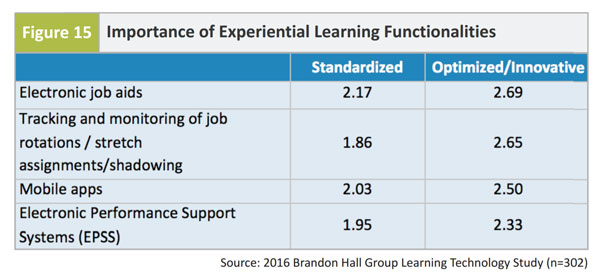When looking at how to keep an organization in top form, learning and development can be one of the best ways. The Association for Talent Development, based in the United States, concludes that “organizations are more competitive, agile, and engaged when knowledge is constantly and freely shared.”
In fact, after surveying around 830 companies in 2015, they found that organizations with a culture of learning were some of the highest performers. They also found that they attracted more talented employees and had higher levels of customer satisfaction.
Research done through LinkedIn found that the main way for employees to be productive and achieve goals is for employers to provide them with opportunities for continuous learning. This helps employees continue to improve their skills and be more flexible and adaptable, as changes related to technology and other workplace matters can arise quickly. When continuous learning is supported employees feel valued, helping boost employee engagement and retention.
Seeing how beneficial learning and development programs are, why is it that only 31% of organizations surveyed had well developed learning and development programs?
The answer seems to come in the form of what some of us love and what some of us love to hate: technology. The challenges arise when technology advances, generations in the workforce change, and expectations about business evolve.
The current state of L&D
As we discuss in our recent eBook created with Teamfluent – Learning and Development Trends: How Technology Enables Continuous Learning – there are three main factors that seem to be driving forces in the changes occurring in learning and development. Due to globalization and the shrinking world, businesses have to compete with other organizations around the world, no longer just in their community or country. Companies need to use technology to help employees continuously learn and develop skills so that the company can stay competitive in the marketplace.
Mobile devices have made learning available to even more people and almost anywhere. Learning and development programs are less in control of learning as employees can find courses on almost any topic on a mobile device.
Employees are also learning that learning can help them advance their careers. There are more requests from Millennials and Generation Z employees to have learning opportunities on a variety of topics in an easily accessible manner like an online learning environment.
These forces disrupt the culture of learning in the organization, requiring leaders to continuously learn about and adapt to changes. Leaders who don’t, fall behind and miss the benefits of highly developed learning and development programs.
This may be a part of why almost 80% of organizations are not creating plans that incorporate the changes in technology, according to the 2016 Brandon Hall Group Learning Technology Study.
The majority of organizations (45%) have technology plans and have used learning technologies, but do not have much consistency or long terms goals and planning to support the implementation of these technologies. Many leaders may see the importance of emerging technologies, but may not know how to use them or implement them. Organizations that implement new technologies without having a plan may not get the results they are looking for. A well thought out plan will improve the chances of success and increase the positive impacts.
While there is a general link between learning technologies and improvements in productivity and engagement, the impact is much greater when organizations have a more organized and structured implementation strategy.
Finding a strategy
CB Insights, a firm tracking venture investments, found that during the first 6 months of 2015, $3 billion was invested into learning and educational start-ups. Almost $1 billion of that was focused on learning and education in the corporate world. With so much investment it is only a matter of time before something new comes along.
Many businesses are starting to understand the importance of technology and implement it in a structured manner. Brandon Hall Group’s study found that the number one learning and development strategy through 2017 is the exploration of new technologies. This shows the importance that companies place on finding out what technologies they can incorporate into their programs. Social and mobile technologies are the two most important technologies for many organizations.
The way to navigate this and to stay ahead of the trends is to establish a strategy that can adapt as technology evolves. Looking back at the almost 80% of companies that are Standardized or below in their technology strategies, it is not surprising to find out that exploring new technologies is not one of their top 3 priorities. Being stuck in the old way of doing things without any vision for the future seems to impact how well they explore and plan for new technologies. It is the number one priority for companies in the Optimized/Innovative group.
This is even more evident when looking at the data that shows that companies without a clear strategy do not see the importance in informal learning. In every category, businesses in the Optimized/Innovative category were more likely to say that technology is essential.
Importance of Informal Learning Functionality (Essential/Critical)
Source: 2016 Brandon Hall Group Learning Technology Study
Why strategy matters
Even though technology and learning have had some kind of connection for years now, many companies are still having trouble incorporating external technologies into their learning structures. Leaders can identify ways that technology can impact their L&D programs (online certificates, massive open online courses/MOOCs, and social media learning) but 61% of executives state they have problems moving their organizations toward these types of learning styles.
When companies have a clear strategy about incorporating technology into their L&D programs, they are more satisfied with technology. In the Standardized group, the average score for satisfaction is around 2, on a 4-point scale. For the Optimized/Innovative group the score the average is closer to 2.5.
Satisfaction Rate for Experiential Learning Functionality (4-point scale)
Working with, not against, technology
Businesses with the most success are changing how they view learning and development, as the business environment evolves. They create an employee-centric process where learning is a continuous event that the entire company is a part of.
No longer is learning and development a periodic event managed by HR. It is more important than ever to understand the changes in the business world, how technology impacts business and learning, and creating plans to adapt to these changes.
Image via @aleksdorohovich








Insightful Ilie! These are absolutely true and it is imperative to understand this for 21st Centry leaders. Learning & Development make the team how to be more creative, exploring new ideas, engage more stakeholders, becomes resilient about the new changes it may be cultural or technological will give the degree of freedom in new innovation to truly understand the core needs of your business, why and how to serve others!! We also believe in our organization at BoldToLead to inspire education (www.boldtolead.com ) Thank you for sharing!!